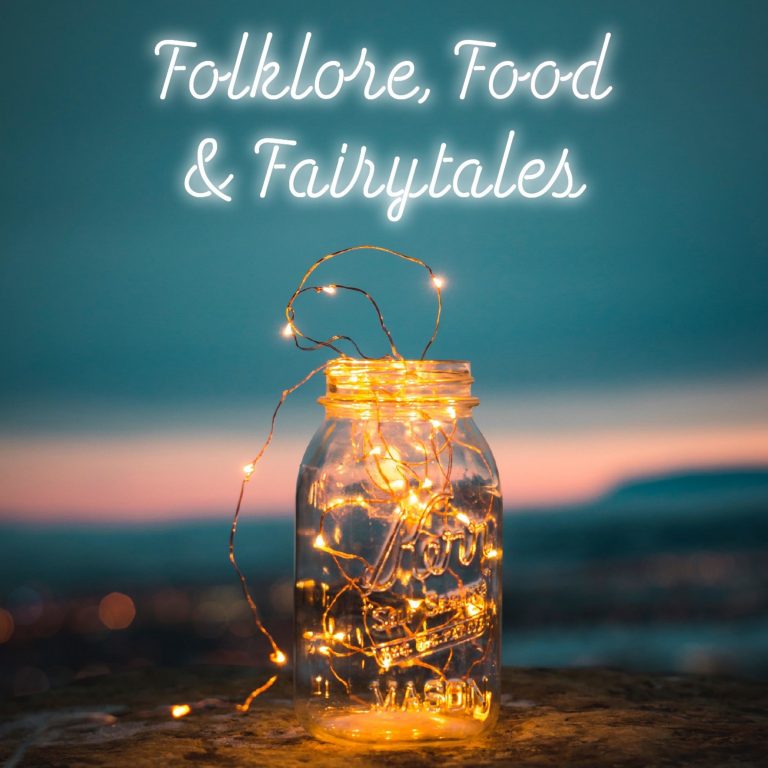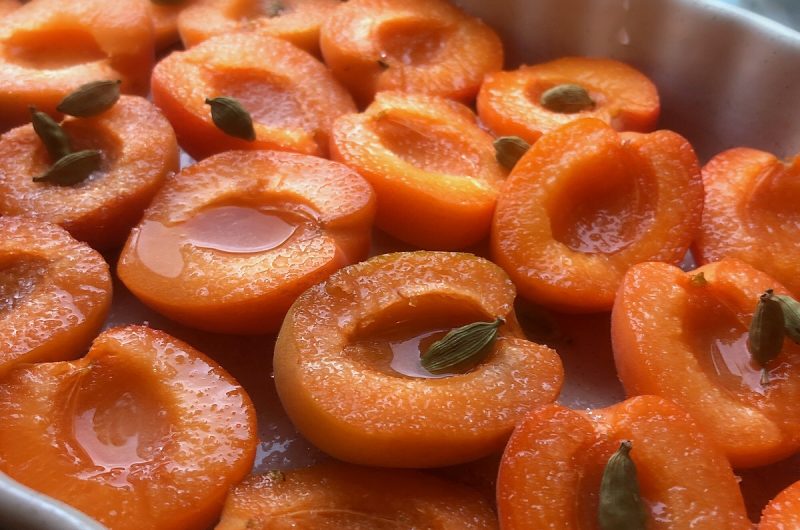In which we discover that betrayal is occasionally inevitable, sometimes all you need is a magical new frock & a talking fish and that apricots can be the key to overcoming misfortune. A tale of magical fruit, horror, betrayal, disguise, posh frocks and a King who is not easily fooled but fairly easily persuaded.
In which we discover that betrayal is occasionally inevitable, sometimes all you need is a magical new frock & a talking fish and that apricots can be the key to overcoming misfortune. A tale of magical fruit, horror, betrayal, disguise, posh frocks and a King who is not easily fooled but fairly easily persuaded.
Episode Recipe – Apricot Crème Brulée
If you want to know more about anything discussed on this podcast you can visit the episode web page or visit Further Reading.
You can also find out more at Hestia’s Kitchen which has all past episodes and the connected recipes on the blog. If you’d like to get in touch about the podcast you can find me on Twitter or Instagram at @FairyTalesFood

Do I have a Tale Type for You?
Well, what did you think? Its definitely an interesting tale even If gory in parts. Would it surprise you that it contains elements from at least three different tale types. The two most significant ones are ATU404 The Blinded Bride and ATU 510B Cinderella – Donkeyskin but I’ll leave you to work out the others. Due to the crossover in the tales we escape the incest theme which usually accompanies the Donkeyskin Tale type as well as the abuse from the heroine’s future husband.
Basile Again
Isabelluccia still does not have an easy time of it, blinded and left for dead by her stepmother and stepsister. She also suffers the betrayal of the woman that apparently loved her and brought her up. She wasn’t just an interloper brought into the house by an unthinking father. I promise I’m only going to mention Basile briefly but this is very similar to the betrayal of Cat Cinderella by her beloved governess in his Tale of Tales. Isabeluccia does have magic help though in the form of the red & gold fish. I’ll admit he plays a smaller role in the original tale but I felt he was crying out for a bigger part in the tale so I gave him one.
Another Feckless King
The King in this tale is another slightly feckless young man as appears to be the tradition of royalty in the Italian states. The story comes from Siena so I have left it set in the forest and hills of Tuscany although my terrible geography means that I didn’t quite how far poor Isabelluccia must have had to walk to get to the sea shore. There are other Italian variants of this story and some are even gorier than this one. The helpers are also more peasants rather than magical fish. The fish captured my imagination and I felt the need to avoid further mutilations. They aren’t unique to the Italian tales either, there is an Armenian one which is deeply disturbing.
An Old Woman Skin
In the original tale, Isabelluccia wears an old woman skin rather than an old woman cloak to disguise her whilst she tries to regain her royal groom and outsmart her stepmother and stepsister. This fits in with the donkey skin tale although she is not wearing it to hide from her father. She also has three fabulous dresses but they are not described so I took the liberty of imagining them and creating them on the page. The creation of them in reality being far beyond me. They do however add to the surreallness of the tale.
The hiding of the ring in the food is also pure Donkeyskin. There are several possible endings for the stepmother and stepsister and I took the coward’s way out and went for a soft version. I’d had enough of putting people in barrels and exploding them in my Two Little Pizzas episode and I couldn’t face the whole eye for an eye narrative.
Uncomfortable Tales
You can see why the Donkeyskin tale type which includes the British tales of Cap O Rushes, Mossycoat and Tattercoats as well as Donkey skin, All Kinds of Fur, Catskin, Asheypelt and the Princess in the Suit of Leather is no longer widely told. This is even more true of The Blinded Bride. Neither of these tale types are comfortable and contain some very difficult themes but they have a long history which was suppressed in many English speaking countries during the Victorian age.
Italian Food Imagery for the Win
This is another Italian tale and again the food imagery is very rich but very concentrated on fruit this time. Fruit in tales and mythology often demonstrates abundance and fertility and it is noticeable that the true bride is the only one who can produce the fruit when non-one else can manage it. I also find it interesting that the four fruits in this story are the all the ones that have been associate with the forbidden fruit of the Garden of Eden
Why choose apricots out of the four fruits mentioned? Well, mostly because I’ve already made episodes about figs and pomegranates and I’m not the biggest fan of apples. Also they are fascinating with a much longer and more interesting folklore and history than you’d think.
Apricots or Apples?
We should probably look at the folklore first. They have been suggested as the real fruits behind the ‘golden apples of Hesperides’. The miraculous golden apples were guarded by a hundred-headed dragon and the nymphs of Hesperides and getting them was one of the Labours of Hercules. Some say that golden apple was the Greek term for apricot. I love Greece but my Greek is just about good enough to say hello and order Spanakopita so I definitely can’t say one way or another. I will add though that apples are very hard to grow in Greece and are usually red or green rather than golden.
Armenia – an Honourable Mention
One definite fact is that the apricot is the symbol of Armenia and the yellow in the Armenian flag is supposed to represent apricots. They also have an ancient wooden instrument called a Duduk which is always made from the wood of the apricot tree. According to legend the apricot tree was the only tree on Noah’s Ark which is why it grows such gorgeous fruit at the foot of Mount Ararat.
Roses Really
It is believed they or at least their wild ancestors originated in China and they are surprisingly a member of the rose family which I have only just discovered. There are related to the plum, peach, cherry and almond which may explain why their flavours are so complimentary. Truly ripe apricots are a thing of mouth-watering beauty. John Ruskin described them as ‘shining in a sweet brightness of golden velvet’.
Unfortunately the further you are from the place they are picked the less inspiring they become, hence why the British made significant efforts to grow them despite the unpropitious climate. King Henry VIII’s gardener brought the apricot to England from Italy in 1542. They weren’t very successful until the 18th century but they did then take off after Lord Anson developed a variety call Moor Park after his ancestral seat.
Cold & Moist
They had a mixed history as a food product in Medieval Europe and England in particular. In the medieval philosophy of humours apricots were considered cold and were likely to decay quickly in the stomach. Lets just say that they weren’t raving about them but they did make some remedies from them including inflammations, ulcerous swellings and earache. At some point however people must have started to enjoy them otherwise Royal gardeners wouldn’t have been trying to import them.
A Herball Blancmange
The first written reference we have for them is in 1562 which I couldn’t find a copy of sadly but I did manage to track down a version A niewe Herball from 1578 in which they were mentioned and it confirms the medieval opinions above. However by 1660 recipes for baking them in tarts and preserving them when ripe were appearing in Robert May’s Accomplisht Cook. In 1773 they are preserving them, drying them and making wine out of them as well as making apricot puddings and pickling them by 1810. There is a particularly delicious sounding recipe for Apricot Blanc-Mange from Eliza Action in 1860.
Pudding Finally
We do import most of our apricots now and as a result probably aren’t eating them at their best. Dried apricots are very popular as they retain a lot more of the apricots true flavour. My recipe is an excellent way to bring sad under flavoured apricots to life and make them into a wonderful pudding.
Apricot Crème Brulée
6
servings1
minute20
minutesIngredients
7 Apricots
500g Greek Yoghurt
300ml Double Cream
6-8 green cardamon pods
2 tsp rosewater
Soft brown sugar
Directions
- Firstly the number of apricots is a rough guess. It doesn’t really matter as long as you have enough to make a reasonable layer of whatever dish you use.
- Heat oven to 200 degrees C. Cut the apricots in half and remove stones and then place in a layer in an oven proof dish
- Sprinkle over 2-3 tsp sugar & scatter over rosewater and cardamon seeds
- Bake in oven for around 15 -20 minutes until apricots are just soft.
- Remove from oven and allow to cool, then place in a nice heatproof dish
- Whilst the apricots are cooling, whip the double cream & then fold in thick Greek yoghurt
- Spoon yoghurt/cream mixture
- Sprinkle over enough sugar to cover the dish in a thin layer and then melt under a hot grill or use a catering blow torch. Be careful to just do it until sugar is melted/caramelised but don’t overheat cream.
Further Reading
https://www.oed.com/view/Entry/9938?redirectedFrom=apricot#eid
Oxford Companion to Food, Alan Davidson, edited by Tom Jaine
The Greenwood Encyclopedia of Folktales and Fairy Tales – Volume 1: A–F Edited by Donald Haase Dodoens ·
A niewe herball, or historie of plantes (transl. Henry Lyte) · 1st edition, 1578 (1 vol.).
Cinderella; three hundred and forty-five variants of Cinderella, Catskin, and Cap o’Rushes, Maria Roalfe Cox
http://khkeeler.blogspot.com/2018/07/plant-story-apricot-folklore.html
http://womenwriters.digitalscholarship.emory.edu/content.php?level=div&id=woolley_170&document=woolley
The Accomplisht Cook – 1660, Robert May
The Complete Housewife or Gentlewoman’s Companion – 1773, E Smith
A New System of Domestic Cookery – 1810, M Rundell
Modern Cookery for Private Families – 1860, Eliza Acton
Featured Image: Photo by Aperture Vintage on Unsplash


